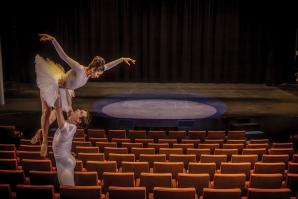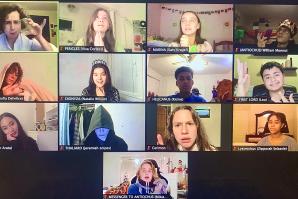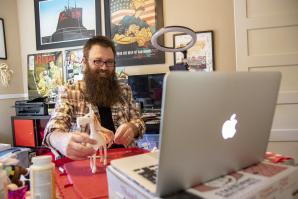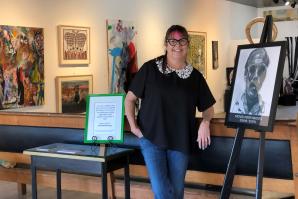Megan Wygant became the executive director of CLARA, the E. Claire Raley Studios for the Performing Arts, when the nonprofit opened in 2016. The organization is housed in the 100-year-old former Fremont School in Midtown Sacramento. Wygant previously worked as an independent consultant for nonprofit organizations and as an assistant general manager for Emerson Stage at Emerson College in Boston. CLARA’s tenants include Alliance Française de Sacramento, Brazilian Center for Cultural Exchange of Sacramento, Capital Stage, McKeever School of Irish Dance, Sacramento Ballet, Sacramento Preparatory Music Academy, Seasons Coffee Roasters and Southside Unlimited. Comstock’s spoke to Wygant about how CLARA has supported its tenants and art education during the pandemic.
CLARA launched in April 2016. What was that like?
The board had already rented out all the space in the building. … I got a lot of calls in those first two weeks — “We’re looking for space.” And I was like, “Well, we’re actually full.” It was very successful for us, but from the perspective of what else do we do, that was sort of the challenge of the first year or so, trying to really identify if we’re full, what else could we provide to the city.
It showed there was a need greater than supply?
There was a need here in Sacramento in particular. … You think about all the different kinds of space the performing arts need: administrative space, rehearsal space, performance space; if you’re doing education outreach, you need classroom space. The physical plant costs of the performing arts, it’s one of the highest line items on the budget. I want to say (it’s) at least 40 percent of most theater companies’ operating budget. … The performing arts, in particular, aren’t considered to be financially sustainable. If you want low ticket prices, but you also want to pay all of your artists a living wage, those two things don’t actually match. So a lot of arts organizations are really dependent on donations to keep going. As an administrator who believes in the arts, my passion’s always been how can you show the financial value that the arts give to the community? And is there a way to kind of trade on that value for lowering the expenses of creating art? And that’s exactly what CLARA does. …
CLARA is (in) a decommissioned school building owned by (Sacramento City Unified School District). They donated the building to us, and they said what we want in exchange is not money. We want arts education in our schools. … And then CLARA’s job is to sort of administrate that relationship and work with the tenants to provide that in-kind rent of arts education back into the school system. …
You put arts into a classroom, and performance goes up. And that’s true just across the board, no matter what the school is, no matter what the economic level is of the school. … You really notice it with students who are living in the poverty line, because there, those incremental changes make a difference. … They’re five times more likely to graduate from high school. … They’re twice as likely to graduate college. … We noticed students are more likely to come to school on days that our programs are in the class.
Can you tell me more about the partnership that made CLARA a reality?
We had this building donated by the school district, and the board of CLARA filled it with cultural tenants — we have eight cultural tenants in the building. Those tenants pay the cost of running the building, and that’s their dollar rent. That comes out to about a third of market value. And then the rest of the rent is paid in-kind back to the school district in the form of arts education. … All of our tenants do some form of after-school and evening classes for either adults or children that helps stabilize the nonprofit income. …
One of the things that has been so interesting about the pandemic is … seeing the way in which our tenants have risen to the challenge.
We now create some of our own programming, (CLARA Classroom, a digital learning platform employing independent artist teachers from the community), and those programs are available (for a cost at other school districts) throughout Sacramento County.
How many of the tenants have been retained over the last year during the pandemic? What accommodations did CLARA make?
Nobody has moved out. And, at this point, all tenants are still paying rent. … We’ve been able to drop rent by 25 percent. As mentioned, the rent paid by the tenants of the building are the expenses of the building. We’re still a new organization, we’re not five years old yet — we don’t have the kind of reserves that allow us to just wipe the rent. … We were very, very active in seeking out disaster relief grants (in the amount of about $100,000). So the (Paycheck Protection Program; Coronavirus Aid, Relief, and Economic Security Act; and) funding through the City of Sacramento. … Those grants covered the expenses that normally would be covered by tenant rent. … I am still actively seeking emergency grants, ideally to keep rates low into the next fiscal year, because we have a long recovery process ahead of us.
We released the tenants from their educational obligations this year, in part because distance learning meant that it was a different expectation from schools.
You have a very small staff. It’s you and two other administrators?
Yes. And one of those is actually brand-new. We brought her on in December (2020) because, this is the other big COVID pivot, in March of last year, everything shut down, all of our programs shut down. … Other county schools, where we are being paid to be there … said, “We’re not going to pay you out unless you can provide distance learning material for us,” and we were like, we need that money, so we went digital. We created (CLARA Classroom), a digital platform for arts education … (for transitional kindergarten through 12th grade) with 20 hours of standards-aligned arts instruction in dance, music and theater. … We’re not limited to Sacramento County, we are not limited to only serving as far as our teaching artists can drive. So we have begun expanding our programs, and … that is why we brought on a new staff member to help us grow that product. … The hope is that we’re integrated into the budget process, and we’ll be in schools in September.
How else does CLARA support the arts community and the industry?
The program that we were about to launch in March of 2020 was a teaching artist training program, because one thing that we found as we began our work here is that there’s a lot of need for arts in the schools. There are some funding opportunities out there to fund arts in schools because people recognize it’s a hot-button item, but there’s actually a pretty limited number of artists who identify as teaching artists and have the tools to be successful in a classroom setting. And so what CLARA wanted to do last year was start this project where we would take artists through a yearlong training program that would talk about curriculum development and classroom management, using the arts as a tool for leadership and also the arts as a tool to manage a classroom. …
We were working with a lot of local nonprofits to train their teaching artists. We were going to reach out to as many independent artists that we could find that were looking for ways to stabilize their own revenue and try to start creating this teaching artist community in Sacramento. And then the pandemic came. … We’re putting (it) off for another year. …
The City of Sacramento has a program called Any Given Child that does train teaching artists, but the assumption with that program is that you already have classroom experience. CLARA’s program would be getting folks up to the level where they could be eligible for Any Given Child.
One of CLARA’s goals was to serve more than 10,000 students during the 2020-21 school year. How did the number change in the past year?
We hit 6,500 (in 2019), and we’ve been up to that point every year, basically doubling the number of kids we serve, so we were like, “Oh, we’ll do 10,000 next year.” … Obviously, an in-person camp wasn’t an option. … Our camps that usually serve 100 kids served 20 (last summer). … We’re sitting at that same 6,500 number (for 2020) that we got in 2019.
In what ways was the digital summer camp last year different?
That was probably the biggest single disappointment for me about the pandemic. … (We had a performing artist teaching) who had been performing on Broadway the week it shut down, we had the hip-hop dance teacher who was J.Lo’s choreographer, we had a Grammy-nominated guitarist teaching our guitar class … and we had 15 of them in these Zoom classes. … But only 20 kids got that experience.
What do you think you would do differently?
We invested in a marketing person to help us create that marketing plan, to help us figure out what we were doing wrong. And we really made it a priority to properly market our camps this year.
Can you tell me about how the tenants have been using the outdoor space?
One of the things that has been so interesting about the pandemic is … seeing the way in which our tenants have risen to the challenge. So you do have tenants like the Music Academy and Alliance Française who just said, “All right, we’re going digital,” and move to Zoom lessons. … Tenants like McKeever School of Dance and Sacramento Ballet who said, “Yeah, we can do digital, but you’re not getting the same experience,” like specifically, the timing … (so) on our campus right now, you would notice that there is an outdoor stage that’s been built, that there’s also a lot of areas of the parking lot that are segmented off with parking cones because the ballet and McKeever Dance … are doing outdoor lessons, and they started that in summer. They taught through 100 degree weather. … They taught while the temperatures dropped. The Sacramento Ballet brought in space heaters. …
And then the Brazilian Center … one of the programs they offered was a cooking class. They do Brazilian food in the space, and their kitchen had just been licensed as a catering kitchen. And so now they’re working with Mercy Pedalers and a few other local nonprofits, and they are creating meals for the homeless, and they’re serving 500 meals a week to homeless folks throughout Sacramento. …
What has been the role of the partners over the past year when many performances and practices were put on pause?
The City of Sacramento’s Office of Arts and Culture has been excellent. … The fact that they went to city council, that Mayor (Darrell) Steinberg said we have to support the creative economy, that money was earmarked for the arts — I believe we’re one of the few cities in the whole nation that had that kind of commitment to supporting the arts. …
Sac Ballet and Capital Stage, who are two professional performing (arts) tenants, and the conversations that the three of us have had around parsing the different county regulations and kind of trying to understand the guidance — because it’s not entirely clear — (has been helpful). … There’s no guidance for the arts. … I can look at guidance for gyms, I can look at guidance for bars, and I can kind of make a best guess between those two. … To have these other two experts who … if we are all at CLARA, I can go down the hall and wave and stand at a distance and be like, “On page five of this county document, this is what I’m seeing; how do you interpret that?” …
Our board … said, “We have faith and trust, we trust Megan, we trust Emili (Danz, education outreach director), and we will do what we need to support the two of you in keeping this organization safe.” And also that they recognized that both Emili and I are women who have young children in the home. … That support really meant a lot. … It made me feel like we were doing it right for the workplace, that we’re … leading an organization right. And I was really proud of that.
Is there anything else that you would like to add?
In terms of the pivots that I’m most excited about, CLARA Classroom is the one. CLARA Classroom is the one that, long term, I think it’s transformational for the organization. That’s the digital platform for arts education, which right now, getting the arts to kids and distance learning is essential. But when we’re back to in-person learning, that platform allows school districts like Galt or (Redding School District), where there’s low access because you can’t get artists to those remote locations, it allows arts to be in those districts. … It also means that CLARA, as a nonprofit, has a revenue stream that is sustainable long term.
Edited for length and clarity.
–
Stay up to date on business in the Capital Region: Subscribe to the Comstock’s newsletter today.
Recommended For You

Out of the Spotlight
The coronavirus pandemic has closed the curtain on the Capital Region’s performing arts, but leaders are hopeful about the future
Last year was a strong one for the performing arts in the region, and 2020 was building on that success, which has led to hope from some local arts leaders that this progress will continue despite the unprecedented shutdown.

Lights, Camera, Virtual Theater
Northern California School of the Arts brings shows to the small screen
The services provided by NorCal School of the Arts aim to support teachers and students in building community and improving mental health in unprecedented times.

Photo Essay: The Arts in Isolation
How Sacramento-area artists and art businesses are creating content and engaging with the community during the pandemic
Many organizations and artists around the Capital Region, including dancers, musicians and comedians, are getting creative with technology to continue sharing their work.

Creativity in Quarantine
Artists and art gallery owners in the Capital Region are finding ways to connect to the public while in isolation
As county and state orders compelled most people to remain at home, the Sacramento art world took a huge hit. However, creativity has continued to flourish in quarantine.




